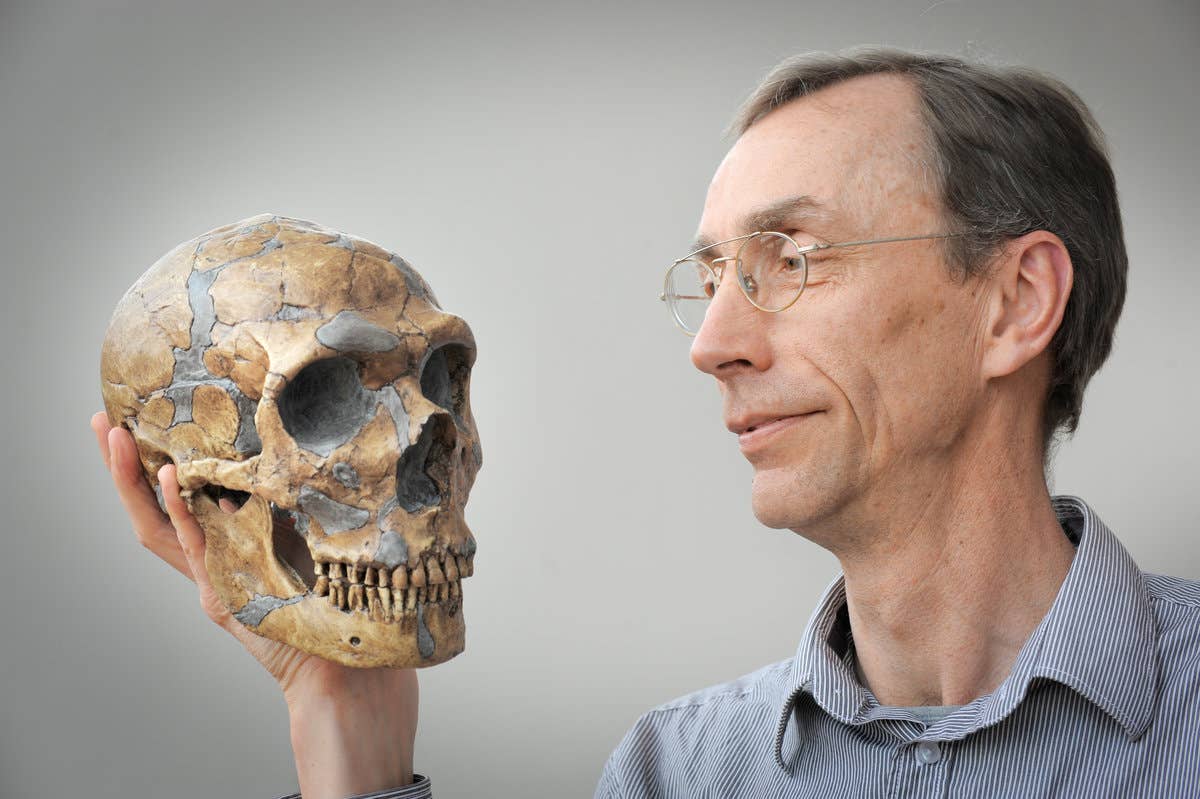Reviving ancient life: Neanderthal bacteria resurrected
In a ground-breaking study that marries ancient genome reconstruction with the cutting-edge field of biotechnology.

[May 5, 2023: Staff Writer, The Brighter Side of News]
A Neandertal skull. (CREDIT: Frank Vinken)
In a ground-breaking study that marries ancient genome reconstruction with the cutting-edge field of biotechnology, a transdisciplinary research team has successfully resurrected natural products of ancient bacteria.
The genetic blueprints of these previously unknown Pleistocene era bacteria, have been used to build a novel biotechnology platform that could potentially revolutionize our understanding of microbial evolution and pave the way for new therapeutic drugs.
Scientists from the Leibniz Institute for Natural Product Research and Infection Biology, the Max Planck Institute for Evolutionary Anthropology, and Harvard University joined forces in this unprecedented exploration of our microbial past.
As the world's most prolific chemists, microbes are responsible for a vast array of natural products, including the majority of our antibiotics and other therapeutic drugs. However, scientific research into these microbial natural products has been largely restricted to currently living bacteria.
Related News
Considering bacteria's three-billion-year presence on Earth, it is clear that an enormous diversity of ancient natural products, potentially rich with therapeutic possibilities, has remained largely undiscovered. This new study has reached a significant milestone in unlocking this ancient genetic and chemical diversity.
Christina Warinner, co-senior author, Associate Professor of Anthropology at Harvard University, and Group Leader at the Max Planck Institute, describes the research as charting "a path for the discovery of ancient natural products and their potential future applications." Pierre Stallforth, co-senior author, Professor of Bioorganic Chemistry and Paleobiotechnology at Friedrich Schiller University Jena, and Head of the Department of Paleobiotechnology at the Leibniz Institute, echoes this sentiment, stating their goal is to illuminate the hidden depths of our microbial past.
A Billion-Piece Jigsaw Puzzle
The reconstruction of ancient genomes is akin to a billion-piece jigsaw puzzle. When an organism dies, its DNA rapidly breaks down, scattering into numerous tiny fragments. Although scientists can identify some of these DNA pieces by matching them with databases, a significant portion of ancient DNA cannot be matched with any known living organism.
Dental calculus (tooth tartar) preserves DNA over millennia, providing unprecedented information about the biodiversity and functional capabilities of ancient microbes. (CREDIT: Werner Siemens Foundation, Felix Wey)
This conundrum has long frustrated microbial archaeologists. However, recent advancements in computational technology are now allowing researchers to piece together these DNA fragments, reconstructing previously unknown genes and genomes.
Alexander Hübner, a postdoctoral researcher at the Max Planck Institute and co-lead author of the study, explains that after three years of relentless testing and optimization, the team managed to reconstruct DNA sequences over 100,000 base pairs long, recovering a wide range of ancient genes and genomes. This breakthrough enables scientists to sequence billions of unknown ancient DNA fragments and systematically arrange them into the long-lost bacterial genomes of the Ice Age.
Lab work on dental calculus (tooth tartar). (CREDIT: Felix Wey/Werner Siemens Foundation)
The research team focused on bacterial genomes encased within dental calculus, or tooth tartar, from Neanderthal and human archaeological specimens, as well as present-day humans. Dental calculus uniquely fossilizes during an individual's lifetime, transforming living dental plaque into a cemetery of mineralized bacteria. The researchers successfully reconstructed several oral bacterial species and discovered other, previously undescribed, species.
An unknown member of Chlorobium was among the species discovered. Its highly damaged DNA evidenced its advanced age, and it was found in the dental calculus of seven Paleolithic humans and Neanderthals. Intriguingly, all seven Chlorobium genomes contained a biosynthetic gene cluster of unknown function.
"The dental calculus of the 19,000-year-old Red Lady of El Mirón, Spain, yielded a particularly well-preserved Chlorobium genome," remarks Anan Ibrahim, a postdoctoral researcher at the Leibniz Institute and co-lead author of the study.
The Birth of 'Paleofurans'
With these ancient genes now in their possession, the research team took the bold step of bringing them into the laboratory to decipher their purpose. In an unprecedented move, synthetic molecular biotechnology was utilized to enable living bacteria to produce the chemicals these ancient genes encoded.
The ambitious endeavor marked the first successful application of this technique to ancient bacteria. The result was the discovery of a new family of microbial natural products, which the researchers aptly named "paleofurans". Martin Klapper, postdoctoral researcher at the Leibniz Institute and co-lead author of the study, celebrates this as the initial step towards unveiling the hidden chemical diversity of Earth's past microbes. This pioneering discovery adds a thrilling time dimension to the exploration of natural products.
A Novel Collaboration: The Birth of a New Field
The triumphant outcome of this study is a testament to the power of interdisciplinary collaboration. The project, which received funding from the Werner Siemens Foundation, brought together archaeologists, bioinformaticians, molecular biologists, and chemists. Together, they navigated the choppy waters of technological and disciplinary barriers to break new scientific ground.
Microbes are Nature’s greatest chemists, and by studying the genomes of ancient bacteria, it may be possible to discover new uses for very old molecules. (CREDIT: Werner Siemens Foundation, Felix Wey)
Pierre Stallforth lauds the team's collective effort, acknowledging how their collaborative approach enabled the development of technologies capable of recreating molecules produced a hundred thousand years ago. Christina Warinner echoes his sentiment, underscoring the importance of building bridges between the humanities and natural sciences in the pursuit of scientific advancements.
Looking to the future, the team intends to leverage this newly developed technique to find new antibiotics. Their pioneering work has not only offered an unprecedented glimpse into the microbial world of the Pleistocene era but has also forged a path for the potential development of novel therapeutic drugs. By resurrecting the rich molecular secrets of Paleolithic microorganisms, these scientists are pushing the boundaries of biotechnology, ancient genome reconstruction, and our understanding of life on Earth.
For more science and technology stories check out our New Discoveries section at The Brighter Side of News.
Note: Materials provided above by The Brighter Side of News. Content may be edited for style and length.
Like these kind of feel good stories? Get the Brighter Side of News' newsletter.



